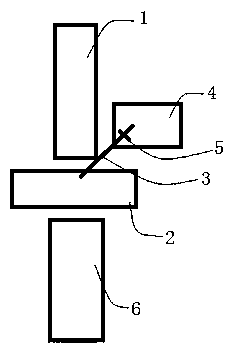Method for extracting anchorage-dependent cells and extracting device for method
An extraction method and a technology of adherent cells, applied in the field of biological cells, can solve problems such as separation and extraction difficulties, troublesome operation, and error-prone, and achieve the effects of reducing the possibility of error, convenient operation, and simple structure
- Summary
- Abstract
- Description
- Claims
- Application Information
AI Technical Summary
Problems solved by technology
Method used
Image
Examples
example 1
[0032] A method for extracting adherent cells, comprising the following steps:
[0033] (1) Spread polyacrylamide hydrogel on the bottom surface of the cell culture well plate with a thickness of 1mm; use phosphate buffered saline (PBS buffer) to soak the polyacrylamide hydrogel for 7 days to eliminate the impact of the hydrogel on Cell toxicity.
[0034] (2) The polyacrylamide hydrogel treated in step (1) was irradiated with ultraviolet light for 20 minutes under the condition of soaking in PBS buffer solution, wherein: the wavelength of ultraviolet light is 313nm, and the ultraviolet irradiance is 356μW·cm -2 ; The hydrogel can be sterilized by ultraviolet irradiation, so that the cell culture can be carried out in a sterile environment;
[0035] After that, the PBS buffer was sucked away, and the polyacrylamide hydrogel was soaked with Sulfo-Sanpah solution for 1 hour. Sulfo-Sanpah solution is a cross-linking agent that can act as a bridge between polyacrylamide hydrogel a...
example 2
[0046] A method for extracting adherent cells, comprising the following steps:
[0047] (1) Spread polyacrylamide hydrogel on the bottom surface of the cell culture well plate with a thickness of 0.75mm; soak the polyacrylamide hydrogel in phosphate buffered saline (PBS buffer) for 15 days.
[0048] (2) The polyacrylamide hydrogel treated in step (1) was irradiated with ultraviolet light for 36 minutes under the condition of soaking in PBS buffer solution, wherein: the wavelength of ultraviolet light is 340nm, and the ultraviolet irradiance is 480μW·cm -2 ;
[0049] After that, the PBS buffer was sucked away, and the polyacrylamide hydrogel was soaked in Sulfo-Sanpah solution for 2.5 hours. - The concentration of Sanpah solution is 0.75mg / ml;
[0050] Afterwards, UV radiation for 40 minutes, and then let it stand for 2.5 hours;
[0051] After that, the Sulfo-Sanpah solution was sucked away, and the surface of the hydrogel was incubated with serum-free medium for 12 hours; ...
example 3
[0060] This example is basically the same as Example 2, except that the preparation steps of polyacrylamide hydrogel are slightly different, as follows:
[0061] a. acrylamide is configured into a 30wt% aqueous solution, methylenebisacrylamide is configured into a 3wt% aqueous solution, and ammonium persulfate is configured into a 5wt% aqueous solution for later use;
[0062] b. Weigh 2ml of acrylamide solution, 1.7ml of methylenebisacrylamide solution, 2.3ml of water, 120μl of ammonium persulfate solution and 6μl of tetramethylethylenediamine; mix well and add to Bio-Rad vertical glue pouring rack , standing at 30°C for 4 hours.
[0063] The obtained polyacrylamide hydrogel has an elastic modulus of 55.02kPa, has a certain degree of brittleness, is easy to separate and dig out, and has good light transmittance, which facilitates the observation of cells in the gel.
PUM
| Property | Measurement | Unit |
|---|---|---|
| Concentration | aaaaa | aaaaa |
| Elastic modulus | aaaaa | aaaaa |
| Concentration | aaaaa | aaaaa |
Abstract
Description
Claims
Application Information
 Login to View More
Login to View More - R&D
- Intellectual Property
- Life Sciences
- Materials
- Tech Scout
- Unparalleled Data Quality
- Higher Quality Content
- 60% Fewer Hallucinations
Browse by: Latest US Patents, China's latest patents, Technical Efficacy Thesaurus, Application Domain, Technology Topic, Popular Technical Reports.
© 2025 PatSnap. All rights reserved.Legal|Privacy policy|Modern Slavery Act Transparency Statement|Sitemap|About US| Contact US: help@patsnap.com

